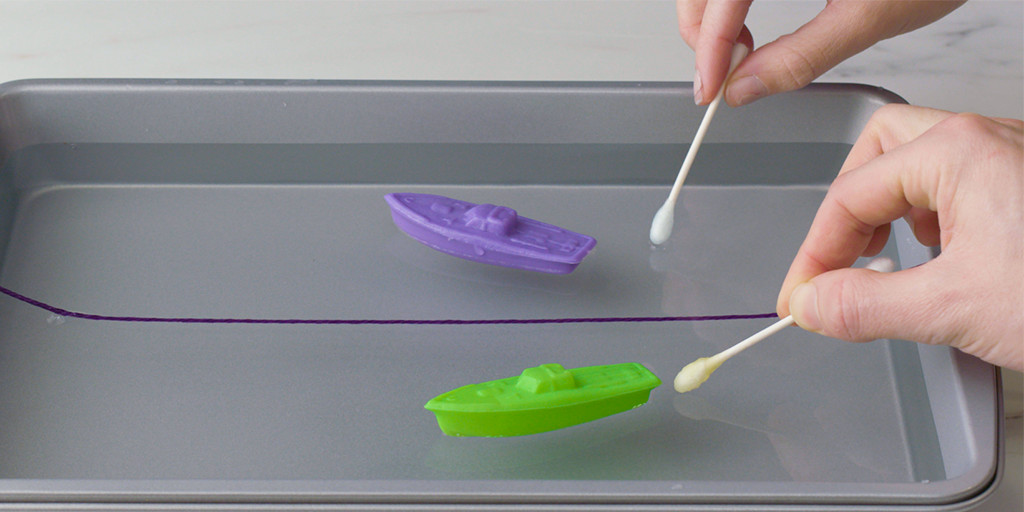Scientific thinking isn’t just something your children learn in school. It’s how they naturally examine the world around around them by asking questions like, “How does it snow?” or “Why is the sky blue?” And when you encourage your children to ask questions, investigate, and seek answers, you encourage them to be curious and confident.
The best way to do that? Introduce fun science experiments for kids at home.
“Children ages 2-7 are optimistic about their ability to learn new skills, and eager to ask questions, so it’s a great time to introduce science activities.” says Erica Peterson, founder of Science Tots, an organization that powers early STEM learning.
Research shows that children have formed their opinion of science by the age of 7, and when you bring science out of the classroom, you increase the likelihood that your children will develop a lifelong love of it, and help them understand that science is something they do, not memorize.
We found a simple soap boat race to spark your children’s scientific curiosity from the comfort of your kitchen. The key to conducting kitchen science with your family? Finding experiments you can do at home with household items that encourage imagination and exploration.
What Materials You’ll Need:
- A shallow dish
- Plastic boats (that can float) or any small object that floats
- Cotton swabs
- An empty ice tray (or other small dishes)
- Different kinds of liquid, we recommend:
- Dish soap
- Hand soap
- Vinegar
- Oil
- Glitter (or anything flaky. Herbs work too!)
- String or yarn
Instructions:
Step 1: Fill your shallow dish with water.
Step 2: Have your children sprinkle glitter on top.
Step 3: In the empty ice tray, fill the cavities with your various liquids. Put a cotton swab in each. (You or your children can do this step.)
Step 4: Ask your children to put the tip of a dry cotton swab in the water.
Step 5: Now, have them take the cotton swab from the dish soap and put it in the water.
Watch closely. What happened? If you followed the instructions, you saw your glitter separate—and here’s why.
The molecules that are on the surface of the water cling tightly to each other. This is called surface tension (think of it as an imaginary skin on top of the water). So, when the cotton swab with the dish soap hits the surface of the water, the water molecules spring apart, bringing the glitter with them.
Now that we have the basic concept down, it’s time to test the other liquids in the water dish. Liquids with lower surface tension will move toward liquids with higher surface tension. It’s kind of like a game of tug of war where the higher surface tension will always win. It’s also known by places like NASA as the Marangoni Effect, in case you want to read up.
Our recommendation: If your child is old enough, have them write down what they think will happen with each liquid before they test, teaching them the meaning of the word “hypothesis.” The key is to assure them that it’s okay to not know the answer. Scientific thinking is not about knowing the answer—it’s about trying to find it through testing and investigating together.
After you test each liquid, based on what happens, have your child(ren) try to determine whether that liquid had higher or lower surface tension than the water.
Once they’ve tested all their liquids, based on their results, have your child(ren) choose which liquid they would like to race with.
Soap Boat Race Next Steps:
Step 1: Empty the water dish and fill it again. Don’t add glitter this time.
Step 2: Put a piece of string down the middle of the dish to make separate lanes for each boat.
Step 3: Place each boat on the same end of the dish and have your child(ren) ready with a cotton swab with their liquid on it.
Step 4: At the same time, both racers should dip their cotton swab behind the boats as many times as needed to reach the other side. The soap boat that makes it to the other end first wins!
After you race with your child, ask them to tell you what makes their boat go faster and why they think that is. Hint: It all comes back to surface tension. Soaps, especially concentrated ones like dish soap, decrease surface tension in water.
Why? Because soap is a surfactant, meaning it attracts both oil and water. So, when the detergent hits the water, it attracts the water molecules to it, therefore breaking the surface tension.
After your experiment is over, take the time to research other examples of surface tension in everyday life. You could even have a discussion on how those soap molecules clean the oil off your dishes by attracting them.
Soap, similar to what it did in our boat race, disrupts the arrangement of water (and oil) molecules on your dishes, allowing them to mix when they normally wouldn’t [internal link to oil & water article] and lifting the grease off of your plates and pots. See, science is everywhere—not just in the classroom.
Who knows, you may even get your kids more interested in chores (you can thank us later)—or at the very least, ready for more fun kitchen science experiments. Happy experimenting!



